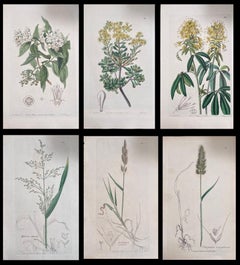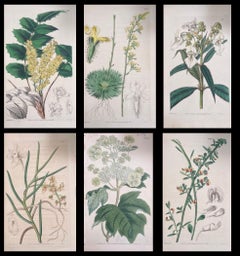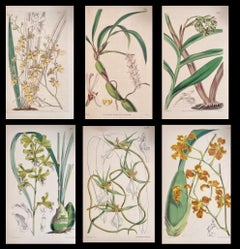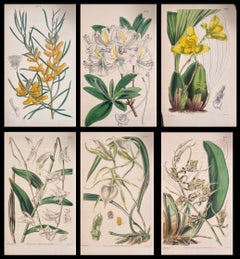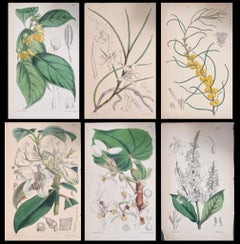19th Century Still-life Prints
to
10
219
38
18
1
1
Overall Width
to
Overall Height
to
63
5
4
12
11
7
5
4
211
277
2,313
1,665
11
19
32
27
91
229
319
480
537
220
182
257
20
62
46
24
18
17
15
15
15
13
13
10
5
5
4
3
3
3
3
2
2
108
91
23
23
23
35
14
83
64
Period: 19th Century
Set of Six Fine Antique British Hand Coloured Botanical Prints, circa 1900's
Located in Cirencester, Gloucestershire
Set of Six Hand Coloured Botanical Prints/Lithographs and Engravings
Published by G. Ridgway, S. Curtis, W. Baxter and W. Fitch
Early Mid 19th Century
Size: image: 8.5 x 5.5 inches
P...
Category
Art Deco 19th Century Still-life Prints
Materials
Color
Set of Six Fine Antique British Hand Coloured Botanical Prints, circa 1900's
Located in Cirencester, Gloucestershire
Set of Six Hand Coloured Botanical Prints/Lithographs and Engravings
Published by G. Ridgway, S. Curtis, W. Baxter and W. Fitch
Early Mid 19th Century
Size: image: 8.5 x 5.5 inches
P...
Category
Art Deco 19th Century Still-life Prints
Materials
Color
Set of Six Fine Antique British Hand Coloured Botanical Prints, circa 1900's
Located in Cirencester, Gloucestershire
Set of Six Hand Coloured Botanical Prints/Lithographs and Engravings
Published by G. Ridgway, S. Curtis, W. Baxter and W. Fitch
Early Mid 19th Century
Size: image: 8.5 x 5.5 inches
P...
Category
Art Deco 19th Century Still-life Prints
Materials
Color
Set of Six Fine Antique British Hand Coloured Botanical Prints, circa 1900's
Located in Cirencester, Gloucestershire
Set of Six Hand Coloured Botanical Prints/Lithographs and Engravings
Published by G. Ridgway, S. Curtis, W. Baxter and W. Fitch
Early Mid 19th Century
Size: image: 8.5 x 5.5 inches
P...
Category
Art Deco 19th Century Still-life Prints
Materials
Color
Set of Six Fine Antique British Hand Coloured Botanical Prints, circa 1900's
Located in Cirencester, Gloucestershire
Set of Six Hand Coloured Botanical Prints/Lithographs and Engravings
Published by G. Ridgway, S. Curtis, W. Baxter and W. Fitch
Early Mid 19th Century
Size: image: 8.5 x 5.5 inches
P...
Category
Art Deco 19th Century Still-life Prints
Materials
Color
Set of Six Fine Antique British Hand Coloured Botanical Prints, circa 1900's
Located in Cirencester, Gloucestershire
Set of Six Hand Coloured Botanical Prints/Lithographs and Engravings
Published by G. Ridgway, S. Curtis, W. Baxter and W. Fitch
Early Mid 19th Century
Size: image: 8.5 x 5.5 inches
P...
Category
Art Deco 19th Century Still-life Prints
Materials
Color
Set of Six Fine Antique British Hand Coloured Botanical Prints, circa 1900's
Located in Cirencester, Gloucestershire
Set of Six Hand Coloured Botanical Prints/Lithographs and Engravings
Published by G. Ridgway, S. Curtis, W. Baxter and W. Fitch
Early Mid 19th Century
Size: image: 8.5 x 5.5 inches
P...
Category
Art Deco 19th Century Still-life Prints
Materials
Color
Set of Six Fine Antique British Hand Coloured Botanical Prints, circa 1900's
Located in Cirencester, Gloucestershire
Set of Six Hand Coloured Botanical Prints/Lithographs and Engravings
Published by G. Ridgway, S. Curtis, W. Baxter and W. Fitch
Early Mid 19th Century
Size: image: 8.5 x 5.5 inches
P...
Category
Art Deco 19th Century Still-life Prints
Materials
Color
Set of Six Fine Antique British Hand Coloured Botanical Prints, circa 1900's
Located in Cirencester, Gloucestershire
Set of Six Hand Coloured Botanical Prints/Lithographs and Engravings
Published by G. Ridgway, S. Curtis, W. Baxter and W. Fitch
Early Mid 19th Century
Size: image: 8.5 x 5.5 inches
P...
Category
Art Deco 19th Century Still-life Prints
Materials
Color
Set of Six Fine Antique British Hand Coloured Botanical Prints, circa 1900's
Located in Cirencester, Gloucestershire
Set of Six Hand Coloured Botanical Prints/Lithographs and Engravings
Published by G. Ridgway, S. Curtis, W. Baxter and W. Fitch
Early Mid 19th Century
Size: image: 8.5 x 5.5 inches
P...
Category
Art Deco 19th Century Still-life Prints
Materials
Color
Set of Six Fine Antique British Hand Coloured Botanical Prints, circa 1900's
Located in Cirencester, Gloucestershire
Set of Six Hand Coloured Botanical Prints/Lithographs and Engravings
Published by G. Ridgway, S. Curtis, W. Baxter and W. Fitch
Early Mid 19th Century
Size: image: 8.5 x 5.5 inches
P...
Category
Art Deco 19th Century Still-life Prints
Materials
Color
Merendera Aitchisoni, antique botanical flower lithograph print
Located in Melbourne, Victoria
Botanical lithograph with original hand-colouring , 1873, by Walter Hood Fitch (1817-1892).
235mm by 145mm (sheet)
Walter Hood Fitch was a Scottish botan...
Category
Naturalistic 19th Century Still-life Prints
Materials
Lithograph
Begonias, English antique flower botanical chromolithograph, 1896
Located in Melbourne, Victoria
'Seedling tuberous Rooted Begonias'
Antique English flower botanical chromolithograph.
Category
Naturalistic 19th Century Still-life Prints
Materials
Lithograph
Set of Six Fine Antique British Hand Coloured Botanical Prints, circa 1900's
Located in Cirencester, Gloucestershire
Set of Six Hand Coloured Botanical Prints/Lithographs and Engravings
Published by G. Ridgway, S. Curtis, W. Baxter and W. Fitch
Early Mid 19th Century
Size: image: 8.5 x 5.5 inches
P...
Category
Art Deco 19th Century Still-life Prints
Materials
Color
Set of Six Fine Antique British Hand Coloured Botanical Prints, circa 1900's
Located in Cirencester, Gloucestershire
Set of Six Hand Coloured Botanical Prints/Lithographs and Engravings
Published by G. Ridgway, S. Curtis, W. Baxter and W. Fitch
Early Mid 19th Century
Size: image: 8.5 x 5.5 inches
P...
Category
Art Deco 19th Century Still-life Prints
Materials
Color
Set of Six Fine Antique British Hand Coloured Botanical Prints, circa 1900's
Located in Cirencester, Gloucestershire
Set of Six Hand Coloured Botanical Prints/Lithographs and Engravings
Published by G. Ridgway, S. Curtis, W. Baxter and W. Fitch
Early Mid 19th Century
Size: image: 8.5 x 5.5 inches
P...
Category
Art Deco 19th Century Still-life Prints
Materials
Color
Set of Six Fine Antique British Hand Coloured Botanical Prints, circa 1900's
Located in Cirencester, Gloucestershire
Set of Six Hand Coloured Botanical Prints/Lithographs and Engravings
Published by G. Ridgway, S. Curtis, W. Baxter and W. Fitch
Early Mid 19th Century
Size: image: 8.5 x 5.5 inches
P...
Category
Art Deco 19th Century Still-life Prints
Materials
Color
Set of Six Fine Antique British Hand Coloured Botanical Prints, circa 1900's
Located in Cirencester, Gloucestershire
Set of Six Hand Coloured Botanical Prints/Lithographs and Engravings
Published by G. Ridgway, S. Curtis, W. Baxter and W. Fitch
Early Mid 19th Century
Size: image: 8.5 x 5.5 inches
P...
Category
Art Deco 19th Century Still-life Prints
Materials
Color
Set of Six Fine Antique British Hand Coloured Botanical Prints, circa 1900's
Located in Cirencester, Gloucestershire
Set of Six Hand Coloured Botanical Prints/Lithographs and Engravings
Published by G. Ridgway, S. Curtis, W. Baxter and W. Fitch
Early Mid 19th Century
Size: image: 8.5 x 5.5 inches
P...
Category
Art Deco 19th Century Still-life Prints
Materials
Color
Set of Six Fine Antique British Hand Coloured Botanical Prints, circa 1900's
Located in Cirencester, Gloucestershire
Set of Six Hand Coloured Botanical Prints/Lithographs and Engravings
Published by G. Ridgway, S. Curtis, W. Baxter and W. Fitch
Early Mid 19th Century
Size: image: 8.5 x 5.5 inches
P...
Category
Art Deco 19th Century Still-life Prints
Materials
Color
Cape Atragene, Henry Andrews antique botanical pink flower engraving print
Located in Melbourne, Victoria
'Atragene Capensis - Cape Atragene'
Native of the Cape of Good Hope.
Original copper-line engraving with original hand-colouring from Henry Andrews' 'The Botanist's Repository', 1...
Category
Naturalistic 19th Century Still-life Prints
Materials
Engraving
Ferns - Platycerium Alcicorne, antique fern botanical colour woodblock print
Located in Melbourne, Victoria
Antique 19th century fern colour woodblock by Benjamin Fawcett after AF Lydon. From Edward J. Lowe’s 'Ferns: British and Exotic', 1867.
Accompanied by a sheet of descriptive text.
...
Category
Naturalistic 19th Century Still-life Prints
Materials
Lithograph
Marica caerulea, antique botanical purple flower engraving
Located in Melbourne, Victoria
Engraving with original hand-colouring. 1834. 230mm by 155mm. From Paxton's 'Magazine of botany and register of flowering plants' by Sir Joseph Paxton.
Category
Naturalistic 19th Century Still-life Prints
Materials
Engraving
Set of Six Fine Antique British Hand Coloured Botanical Prints, circa 1900's
Located in Cirencester, Gloucestershire
Set of Six Hand Coloured Botanical Prints/Lithographs and Engravings
Published by G. Ridgway, S. Curtis, W. Baxter and W. Fitch
Early Mid 19th Century
Size: image: 8.5 x 5.5 inches
P...
Category
Art Deco 19th Century Still-life Prints
Materials
Color
Set of Six Hand-Colored Engravings from Curtis's Botanical Magazine /// Botany
Located in Saint Augustine, FL
Artist: William Curtis (English, 1746-1799)
Title: Set of Six Hand-Colored Engravings
Portfolio: The Botanical Magazine; or, Flower-Garden Displayed
Year: 1801-1809 (Second series)
M...
Category
Victorian 19th Century Still-life Prints
Materials
Watercolor, Engraving, Intaglio
Un Coin de Cuisine - Etching by Charles Meryon - 1870s
Located in Roma, IT
Un Coin de Cuisine is an artwork realized by Charles Meryon in the 1870s.
Etching.
Image size:24x31.
Good conditions.
Realized for the "Société des Aquafortistes. Born on the i...
Category
Modern 19th Century Still-life Prints
Materials
Etching
Ferns - Platycerium Stemmaria, antique fern botanical colour woodblock print
Located in Melbourne, Victoria
Antique 19th century fern colour woodblock by Benjamin Fawcett after AF Lydon. From Edward J. Lowe’s 'Ferns: British and Exotic', 1867.
Accompanied by a sheet of descriptive text.
...
Category
Naturalistic 19th Century Still-life Prints
Materials
Lithograph
Spear-leaved Helonias, Henry Andrews antique botanical flower engraving print
Located in Melbourne, Victoria
'Helonias bullata - Spear-leaved Helonias'
Native of Carolina, North America.
Original copper-line engraving with original hand-colouring from Henry Andrews' 'The Botanist's Repos...
Category
Naturalistic 19th Century Still-life Prints
Materials
Engraving
Northian Moraea. Henry Andrews antique botanical flower engraving print
Located in Melbourne, Victoria
'Morea Northiana - Northian Moraea'
'Native of the Brazils'.
Original copper-line engraving with original hand-colouring from Henry Andrews' 'The Botanist's Repository', 1797-1812...
Category
Naturalistic 19th Century Still-life Prints
Materials
Engraving
Two-coloured-leaved Cineraria. Andrews antique botanical flower engraving print
Located in Melbourne, Victoria
'Cineraria Aurita - Two-coloured-leaved Cineraria'
Native of the Canary Islands.
Original copper-line engraving with original hand-colouring from Henry Andrews' 'The Botanist's Re...
Category
Naturalistic 19th Century Still-life Prints
Materials
Engraving
Winter and Spring
By Jean-Antoine Watteau
Located in Columbia, MO
Jean-Antoine Watteau
Winter – Spring
1841
Hand colored lithograph
14 x 19.5 inches
Framed: 25 x 31 inches
Category
19th Century Still-life Prints
Materials
Lithograph
Sweet-scented Lachenalia. Henry Andrews antique botanical flower engraving print
Located in Melbourne, Victoria
'Lachenalia Fragrant - Sweet-scented Lachenalia'
Original copper-line engraving with original hand-colouring from Henry Andrews' 'The Botanist's Repository', 1797-1812. Accompanied...
Category
Naturalistic 19th Century Still-life Prints
Materials
Engraving
Kaempferia rotunda, antique botanical purple orchid flower engraving
Located in Melbourne, Victoria
Engraving with original hand-colouring. 1834. 230mm by 155mm. From Paxton's 'Magazine of botany and register of flowering plants' by Sir Joseph Paxton.
Category
Naturalistic 19th Century Still-life Prints
Materials
Engraving
Antholyza Fulgens. Henry Andrews antique botanical flower engraving print
Located in Melbourne, Victoria
'Antholyza Fulgens - Refulgent-flowered Antholyza'
Original copper-line engraving with original hand-colouring from Henry Andrews' 'The Botanist's Repository', 1797-1812. Accompani...
Category
Naturalistic 19th Century Still-life Prints
Materials
Engraving
PRÉVOST. Print from Collection des Fleurs et des Fruits
Located in London, GB
Original stipple engraving by Charles-Louis Ruotte, printed in colour and finished by hand.
[Paris, 1805]
Prevost's "Collection des Fleurs et Fruits...
Category
Naturalistic 19th Century Still-life Prints
Materials
Color, Engraving, Handmade Paper
Clianthus puniceus (New Zealand), Benjamin Maund botanical engraving
Located in Melbourne, Victoria
'Clianthus puniceus'
Original engraving with original hand-colouring, 1838.
Native plant of New Zealand.
From Benjamin Maund's 'The Botanist'. 1836-1...
Category
Naturalistic 19th Century Still-life Prints
Materials
Engraving
Flowering Houseleek Plant: A 19th C. Hand-colored Botanical Engraving by Curtis
Located in Alamo, CA
This early 19th century hand-colored double fold-out botanical engraving is entitled "Sempervivum Glutinosum" (Clammy Houseleek), plate 1963, published in London in 1818 in William C...
Category
Naturalistic 19th Century Still-life Prints
Materials
Engraving
Apocynum androsamifolium - French botanical flower engraving by Bessa, c1830
Located in Melbourne, Victoria
'Apocynum androsamifolium' (Fly-trap dogbane or spreading dogbane)
Original copper-line engraving with original hand-colouring.
From 'Herbier general de l'amateur' by Jean Louis A...
Category
Naturalistic 19th Century Still-life Prints
Materials
Engraving
Yucca filamentosa - French botanical flower engraving by Bessa, c1830
Located in Melbourne, Victoria
'Yucca filamentosa' (Adam's Needle)
Original copper-line engraving with original hand-colouring.
From 'Herbier general de l'amateur' by Jean Louis Auguste Loiseleur-Deslongchamps &...
Category
Naturalistic 19th Century Still-life Prints
Materials
Engraving
Morchella Esculenta, Leuba antique mushroom morel fungi chromolithograph print
Located in Melbourne, Victoria
'1-2 Morchella Esculenta 3.5. Morchella Viridis'
Antique Swiss mushroom / fungi chromolithograph, lithographed by H Furrer after Fritz Leuba. The print is titled with the scientific...
Category
Naturalistic 19th Century Still-life Prints
Materials
Lithograph
Agaricus Acris / Deliciosus, Leuba antique mushroom fungi chromolithograph print
Located in Melbourne, Victoria
'1-4 Agaricus Acris 5-9 Agaricus Deliciosus'
Antique Swiss mushroom / fungi chromolithograph, lithographed by H Furrer after Fritz Leuba. The print is titled with the scientific nam...
Category
Naturalistic 19th Century Still-life Prints
Materials
Lithograph
Agaricus Comatus, Leuba antique mushroom fungi chromolithograph print
Located in Melbourne, Victoria
'1-4 Agaricus Comatus 5-6 Agaricus Picaceus'
Antique Swiss mushroom / fungi chromolithograph, lithographed by H Furrer after Fritz Leuba. The print is titled with the scientific nam...
Category
Naturalistic 19th Century Still-life Prints
Materials
Lithograph
Craterellus Clavatus, Leuba antique mushroom fungi chromolithograph print
Located in Melbourne, Victoria
'Craterellus Clavatus'
Antique Swiss mushroom / fungi chromolithograph, lithographed by H Furrer after Fritz Leuba. The print is titled with the scientific n...
Category
Naturalistic 19th Century Still-life Prints
Materials
Lithograph
Purslane-leaved Aizoon. Henry Andrews antique botanical flower engraving print
Located in Melbourne, Victoria
'Aizoon Canariense - Purslane-leaved Aizoon'
Original copper-line engraving with original hand-colouring from Henry Andrews' 'The Botanist's Repository', 1797-1812. Accompanied by ...
Category
Naturalistic 19th Century Still-life Prints
Materials
Engraving
Lily-leaved Ophrys. Henry Andrews antique botanical flower engraving print
Located in Melbourne, Victoria
'Ophrys lilifolia - Lily-leaved Ophrys'
Original copper-line engraving with original hand-colouring from Henry Andrews' 'The Botanist's Repository', 1797-1812. Accompanied by the o...
Category
Naturalistic 19th Century Still-life Prints
Materials
Engraving
Antique Italian Copper Engraving - Female Statue
Located in Houston, TX
Antique copper engraving of a roman female statue, circa 1850.
Original artwork on paper displayed on a white mat with a gold border. Archival plastic s...
Category
19th Century Still-life Prints
Materials
Ink, Paper
Calothamnus Villosa, 19th century Australian native botanical engraving print
Located in Melbourne, Victoria
'Calothamnus Villosa - Villous Calothamnus'
Original engraving with original hand-colouring by S Watts After M Hart, 1827.
Native plant of Australia.
...
Category
Naturalistic 19th Century Still-life Prints
Materials
Engraving
POITEAU/TURPIN. Traité des arbres fruitiers: A Set of Four Apples
By POITEAU, A. and P. TURPIN.
Located in London, GB
POITEAU, A. and P. TURPIN.
Traité des arbres fruitiers: A Set of Four Apples
H. Perronneau for T. Delachausée, Paris, 1807-1835.
A set of Four Apples, fine stipple-engrave...
Category
Naturalistic 19th Century Still-life Prints
Materials
Engraving, Handmade Paper, Watercolor
A Set of Two Hand-Colored Engravings of an Ancient Roman Vase and a Tazza (Cup)
Located in Alamo, CA
This is a pair of framed hand-colored engravings of an ancient vase in the Palizzy Wares style and a silver gilt tazza (cup) with a cover, both from the 16th century. These were engraved under the supervision of Philip De La Motte...
Category
Victorian 19th Century Still-life Prints
Materials
Engraving
Le Mais (Corn on the cob) in woven basket)
Located in New Orleans, LA
Maize by Scholnyk is a mezzotint of ears of corn in a woven basket. This impression is #25 of an edition of 80.
Schkolnyk was born in Paris, France in 1953 and currently resides in...
Category
American Modern 19th Century Still-life Prints
Materials
Mezzotint
$206 Sale Price
44% Off
Flowering Crinum Plant: A 19th C. Hand-colored Botanical Engraving by Curtis
Located in Alamo, CA
This early 19th century hand-colored double fold-out botanical engraving is entitled "Crinum Arenarium" (Water-Island Sand Crinum), plate 2355, published in London in 1822 in William...
Category
Naturalistic 19th Century Still-life Prints
Materials
Engraving
"Snow Ball" Pochior - Grasset
Located in Hinsdale, IL
Pochoir (French for stencil) is a fine art printing technique that was especially popular in France from the late 19th to the early 20th century. It involves applying layers of color...
Category
Art Nouveau 19th Century Still-life Prints
Materials
Lithograph
Nature Morte - Etching by Leon Gaucherel - 1860s
Located in Roma, IT
Nature Morte is an artwork realized by Leon Gaucherel in the 1870s.
Etching.
Image size: 31 x 19
Good condition.
Realized for the "Société des Aquafortistes. Born on the initi...
Category
Modern 19th Century Still-life Prints
Materials
Etching
Poppies and Anemones - Lithograph form Ladies Flower Garden British Wildflowers
Located in Austin, TX
Artist: Lady Jane Webb Loudon (Brittish, 1800 - 1858)
9.5 x 8 in. page.
12 x 14 in. frame.
A color lithographic plate from The Ladies' Flower-Garden of British Wildflowers. By Mrs. ...
Category
19th Century Still-life Prints
Materials
Paper, Lithograph
Red Doyenne Pear: Original 19th C. Hand-colored Engraving by Sir William Hooker
Located in Alamo, CA
This is an original 19th century hand-colored stipple engraving by William Hooker entitled "The Red Doyenne Pear", published in London as plate 14 in the 'Transactions of the Horticu...
Category
Naturalistic 19th Century Still-life Prints
Materials
Engraving
Flowering Houseleek Plant: A 19th C. Hand-colored Botanical Engraving by Curtis
Located in Alamo, CA
This early 19th century hand-colored double fold-out botanical engraving is entitled "Sempervivum Smithii" (Hispid-Stemmed Tree Houseleek), plate 1980, published in London in 1818 in...
Category
Naturalistic 19th Century Still-life Prints
Materials
Engraving
Agave or American Aloe: A Framed Hand-colored Engraving from Robert Thornton
Located in Alamo, CA
This is a framed hand-colored botanical engraving entitled "Agave or American Aloe" by Reinagle for Robert Thornton's publication 'The Temple of Flora, or Garden of the Botanist, Poet, Painter and Philosopher', published in London in 1811. This beautiful botanical was created using several engraving techniques, including aquatint, mezzotint, stipple and line engraving methods. It was printed in color and then finished by hand.
The print is presented in a gold-colored wood frame and a heather green mat, which is enhanced with a gold fillet. The frame measures 21.63" high by 16.63" wide and 1" deep. It is glazed with UV conservation glass. All of the mounting materials are archival. The original text page from the early 19th century publication is attached to the rear of the frame. The print is in excellent condition.
Robert John Thornton (1765-1832) was attracted to natural history at an early edge and created his own botanical garden and an aviary as a boy. He graduated from Cambridge with a medical degree and set up practice as a London. He inherited his family fortune in 1797, which allowed Thornton the opportunity to devote time to his lifelong goal of creating an extensive scholarly work dedicated to the great classical Swedish naturalist, Carolus Von Linnaeus (1707-1778), also known as Carl von Linné...
Category
19th Century Still-life Prints
Materials
Engraving, Mezzotint
A 19th Century Curtis Hand-colored Engraving of a Flowering Clerodendrum Plant
Located in Alamo, CA
This early 19th century hand-colored double fold-out botanical engraving is entitled "Clerodendrum Macrophyllum" (Broad-Leaved Clerodendrum), plate 2356, published in London in 1824 ...
Category
Naturalistic 19th Century Still-life Prints
Materials
Engraving
Flowering Lyons' Chelone Botanical: A 19th C. Hand-colored Engraving by Curtis
Located in Alamo, CA
This early 19th century hand-colored double fold-out botanical engraving is entitled "Chelone Major" (Flowering Lyons' Chelone plant), plate 1864, published in London in 1816 in Will...
Category
Naturalistic 19th Century Still-life Prints
Materials
Engraving
Flowering Air Plant: A 19th Century Hand-colored Engraving by William Curtis
Located in Alamo, CA
This early 19th century hand-colored double fold-out botanical engraving is entitled "Pendulous-flowered Bryophyllum", plate 1409, published in London in 1809 in William Curtis’s 'The Botanical Magazine, or Flower-Garden Displayed'. Bryophyllum pinnatum, also known as the air plant...
Category
Naturalistic 19th Century Still-life Prints
Materials
Engraving
